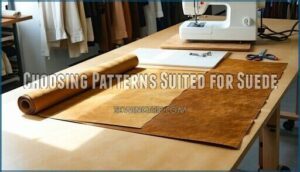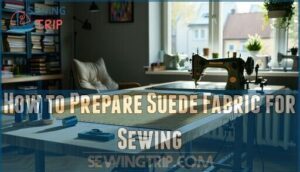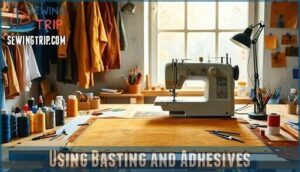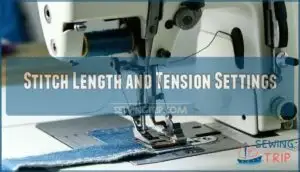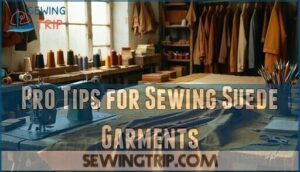This site is supported by our readers. We may earn a commission, at no cost to you, if you purchase through links.
 Learning how to sew suede doesn’t have to feel like wrestling with velvet curtains. Start with synthetic suede – it’s more forgiving than natural hide and won’t judge your rookie mistakes.
Learning how to sew suede doesn’t have to feel like wrestling with velvet curtains. Start with synthetic suede – it’s more forgiving than natural hide and won’t judge your rookie mistakes.
For needles, grab leather ones if you’re working with real suede, or stick with universal needles for the synthetic stuff. You’ll also want a walking foot or roller foot to stop the fabric from shifting around on you.
When cutting, make sure the nap runs downward, then sew with longer stitches and keep that tension nice and loose.
Machine sewing works beautifully once you’ve got the right setup, though hand stitching gives you surgical precision for tricky curves. The secret lies in preparation and the right tools working together.
Table Of Contents
Key Takeaways
- Start with synthetic suede – it’s more forgiving than natural hide, handles machine washing, and won’t punish beginner mistakes while you learn proper techniques
- Use leather needles (size 90/14 to 100/16) for natural suede and universal needles for synthetic – pair with specialty presser feet like Teflon or walking feet to prevent fabric creep and sticking
- Cut all pattern pieces with the nap running in the same direction – run your hand along the fabric to find the smooth direction, then align all pieces consistently for professional texture and color matching
- Adjust your machine settings for success – use longer stitch lengths (3-3.5mm), lower thread tension, and slower speeds to prevent puckering and fabric damage
Can You Sew Suede at Home?
You absolutely can sew suede at home with the right approach and tools.
The key lies in understanding whether you’re working with natural or synthetic suede and choosing techniques that match your fabric’s unique properties.
Natural Vs. Synthetic Suede Differences
Two main types of suede dominate today’s market, and knowing their differences transforms your sewing success. Natural suede comes from animal hides, while synthetic suedes use polyester or microfibers to mimic that luxurious texture.
When choosing suede, two key factors should drive your decision:
- Natural suede lasts 20+ years but costs $10-$100 per yard
- Synthetic suedes resist stains better but may crack after 4-8 years
- Eco friendly options use recycled polyester, reducing virgin materials by 40%
- Natural breathes better with premium moisture-wicking properties
- Faux suede offers easier care and consistent color retention
When you feel natural suede, you’ll notice the difference right away—it scores 3.84 on texture scales compared to synthetic’s 3.24, plus it breathes way better.
But here’s the thing: if you’re just starting out, synthetic suede is your friend. It won’t punish mistakes, costs less, and you can toss it in the washing machine.
Textile science shows natural suede biodegrades completely while synthetic versions create microplastic pollution. Your project goals determine the best choice for sewing with suede success. When selecting suede, consider the suede fabric quality to guarantee durability and sustainability.
Hand Sewing Vs. Machine Sewing Suede
With machine sewing, you’ll zip through suede projects 5-7 times faster than hand stitching. Your sewing machine delivers consistent suede stitching with 30-40% stronger seam durability when you adjust machine speed and fabric tension properly.
Hand sewing gives you precision control for curved seams and repairs, but requires more time for garment construction and suede finishing techniques.
To achieve ideal results, consider using the right thread selection methods for your suede projects.
Choosing The Right Type of Suede for Projects
Think of suede selection like dating—you wouldn’t pick just anyone for a serious relationship, and your project deserves the same careful consideration. Your fabric choice determines everything from durability to how easily you’ll sew those seams.
- Natural suede grades: Premium cow suede offers exceptional stitch tearing strength (186.2 kg/cm) compared to goat suede, making it ideal for structured garments
- Synthetic suedes: Faux suede provides consistent texture and easier fabric care, perfect for beginners tackling their first suede project
- Texture analysis: Match suede weight to your pattern—lightweight synthetic works beautifully for flowing tops, while heavier natural suede excels in jackets
Essential Tools and Materials for Sewing Suede
The right tools can make or break your suede sewing project. Having the proper needles, thread, and accessories sets you up for success before you even touch the fabric.
Best Needles and Thread for Suede
Success with suede fabric hinges on choosing the right needle point types and thread material strength. Leather needles with cutting points work best for natural suede, while universal needles handle synthetic options beautifully. When matching size to your project, start with 90/14 for medium suede or 100/16 for thicker varieties.
Need a quick breakdown? Here’s what works:
| Suede Type | Needle Size | Thread Choice |
|---|---|---|
| Natural/Cow Suede | 90/14 – 100/16 Leather | Bonded Polyester Tex 40-90 |
| Synthetic/Faux | 90/14 Universal | Long-staple Polyester |
| Lambskin | 80/12 Microtex | Tex 30-35 Polyester |
| Heavy/Multi-layer | 110/18 Leather | Bonded Nylon Tex 90+ |
Brand compatibility matters – Schmetz needles paired with Gutermann or Coats thread create rock-solid seams. These synthetic thread options resist tanning chemicals and UV damage while delivering enhanced strength. Master these sewing techniques and your topstitch needlework will look absolutely professional.
Specialty Presser Feet and Accessories
Your sewing machine’s standard presser foot might as well be wearing sneakers to a black-tie event when dealing with suede. Switch to a Teflon foot or walking foot to prevent fabric from sticking and creeping.
These specialty feet glide smoothly over suede’s textured surface, while roller presser feet work magic for edge joining and topstitching techniques that make your projects shine.
Choosing Patterns Suited for Suede
Not every pattern plays nice with suede’s thick, luxurious texture—but the right ones will make you look like a sewing rockstar. Choose simple designs with minimal darts and curved seams.
Straight-line garment construction works best since suede’s texture can mask intricate details. Look for patterns with generous seam allowances and avoid bias-cut styles that fight against the fabric grain.
Topstitching and Seam Options
While most seams can hide behind clever construction, topstitching puts your skills front and center for everyone to see. Your seam choices will make or break your suede project’s professional finish.
You’ve got several solid options for suede seam techniques:
- Flat-fell seams – Perfect for jackets and structured garments
- French seams – Ideal for lightweight synthetic suede pieces
- Bound seams – Professional edge finishing for unlined garments
- Decorative topstitching – Creates beautiful contrast lines on seam allowances
Steam pressing from the wrong side helps seam reinforcement hold its shape better.
How to Prepare Suede Fabric for Sewing
Proper preparation is your secret weapon for turning stubborn suede into a sewing success story. You’ll master the art of washing synthetic suede, cutting with the nap, and handling this luxurious fabric like a pro.
Washing and Drying Suede and Faux Suede
Think suede needs dry cleaning every time you want to wash it? Think again – synthetic suede breaks all the rules and can handle your washing machine like a champ.
Faux suede care is refreshingly simple – toss it in cold water on a gentle cycle for effective suede cleaning. Skip fabric softening sheets when drying methods include machine drying, as they’ll leave oily spots.
Your suede fabric care routine just got way easier than traditional garment care demands.
Cutting Suede With The Nap
Imagine this: one wrong cut against the grain and your beautiful suede transforms from luxurious fabric into a patchy mess that screams "amateur hour."
One wrong cut against the grain transforms luxurious suede into a patchy mess that screams amateur work
That’s why nap direction is your North Star when cutting suede. Run your hand along the fabric—smooth feels silky, rough feels scratchy.
Cut all pattern pieces with the nap flowing in the same direction for consistent texture and professional seam consistency in your finished garment.
Pattern Alignment Techniques
Getting your pattern pieces to line up perfectly on suede is like solving a puzzle where every piece has to face the same direction—mess this up, and your finished garment will look like it was sewn by someone wearing a blindfold. Here’s how to nail pattern alignment every time:
- Mark nap direction arrows on each pattern piece before placing
- Align all grain lines parallel to the suede’s selvage edge
- Double-check seam allowance spacing between adjacent pieces
- Use weights instead of pins to secure sewing patterns
- Verify fabric orientation matches your garment construction plan
Follow these steps and you’ll avoid wasting expensive suede while getting that polished, professional finish.
Marking and Handling Suede Properly
Suede might look intimidating, but with the right marking tricks, you’ll handle it like butter instead of wrestling a stubborn fabric monster. Skip chalk—it disappears into suede’s texture. Instead, use washable fabric markers or tailor’s tacks for precise marks.
Always mark on the wrong side to protect that gorgeous nap directionality. Handle pieces gently, supporting the weight to prevent stretching and maintain consistent texture throughout your garment construction.
Step-by-Step Guide: Sewing Suede Successfully
Now that your suede is prepped and ready, it’s time to master the actual sewing process.
This step-by-step approach will help you conquer suede’s tricky nature and create professional-looking results every time.
Preventing Puckering and Fabric Creep
Nothing ruins a suede project faster than watching your fabric bunch up like an accordion or slide around like it has a mind of its own.
Control your machine’s tension settings and use fabric stabilizers underneath seam allowances. Keep suede under gentle tension as you guide it through—this prevents puckering and gives you creep resistance that keeps everything aligned perfectly.
Using Basting and Adhesives
Working with suede? Toss out your usual pins and clips—they’ll leave marks or slip right off. Instead, try these five methods that actually grip this tricky fabric:
- Hand basting with loose stitches through seam allowances
- Fusible web applied with steam from the wrong side
- Invisible tape along cut edges for temporary hold
- Leather glue sparingly applied for permanent bonds
- Fabric stabilizers underneath for extra seam reinforcement
These adhesive types and basting techniques prevent fabric preparation nightmares while your leather needle glides through smoothly.
Stitch Length and Tension Settings
Your machine’s stitch settings can make or break your suede project faster than you can say "fabric disaster." Set your stitch length to 3-3.5mm for ideal seam stability without creating holes that weaken the fabric. Lower thread tension prevents puckering while maintaining proper fabric feed control.
| Setting | Recommended Value |
|---|---|
| Stitch Length | 3-3.5mm |
| Thread Tension | 2-3 (lower than normal) |
| Presser Foot Pressure | Medium-light |
| Speed | Slow to medium |
| Needle Position | Center |
When you get your machine settings right, you’ll work with suede’s natural stretch instead of fighting against it.
This gives you those clean, professional results that make your leather projects look like they came from a high-end boutique.
Pressing Seams and Shaping Suede
Steam becomes your secret weapon for taming suede’s stubborn seams and coaxing this luxurious fabric into the perfect shape.
Press seams open from the wrong side using steam – never direct heat. This fabric finishing technique makes suede more pliable for garment construction.
Steam helps with texture control and edge sealing, preventing fraying while maintaining suede’s natural softness.
Pro Tips for Sewing Suede Garments
Ready to take your suede sewing from good to gorgeous? These pro tips will transform your projects from homemade to haute couture, covering everything from sourcing mystery fabrics to proper garment care that keeps your creations looking runway-fresh for years.
Working With Mystery and Deadstock Suede
Around 15% of fabric production becomes deadstock, creating remarkable opportunities for suede sourcing. Mystery boxes from textile districts offer 10-14 meters of unique suede fabric at a fraction of retail costs.
These synthetic suedes and faux suede pieces require adjusted patterns since panels run 10-40cm shorter than standard yardage.
Embrace patchwork techniques and mixed-panel construction—you’re not just sewing with unconventional materials, you’re leading the sustainable fashion revolution while reducing textile waste through thoughtful suede upcycling.
Caring for Finished Suede Projects
All that hard work you put into sewing your suede masterpiece doesn’t mean squat if you ruin it with the wrong care routine. Store your suede garments hanging with breathable garment bags for proper suede protection.
For spot removal, use a suede brush or eraser—never water. Professional cleaning methods work best for major stains, while regular fabric conditioning with specialized suede treatments keeps your clothing maintenance game strong.
Avoiding Common Mistakes
Even seasoned sewists who can whip up a blazer blindfolded find themselves stumbling over the same suede pitfalls that can turn a dream project into a fabric nightmare. Here’s what trips up most people:
- Ignoring fabric shrinkage – Always test synthetic suede’s behavior before cutting your final pieces
- Wrong thread selection – Heavy-duty thread prevents seam ripping when suede handling gets tough
- Skipping tension control – Loose tension creates puckering that’ll haunt your finished garment
Elevating Projects With Online Courses and Community
Learning to sew suede isn’t a solo journey—connecting with expert instructors and fellow fabric enthusiasts can transform your projects from good to jaw-droppingly gorgeous. Sew It Academy’s online sewing courses and membership connect you with 800,000+ students tackling everything from fabric selection challenges to expert sewing techniques and projects.
Community Features Benefits
When online sewing tutorials leave you stuck, these communities become your lifeline.
Frequently Asked Questions (FAQs)
What are the best needles for sewing suede?
Between sharp needle tips and heavy-duty needles, leather needles penetrate suede’s dense fibers best. Size 16-18 leather needles handle thick suede perfectly, while denim needles work for lighter synthetic varieties.
Sharp needle tips prevent snagging, guaranteeing clean suede stitching every time.
Can you sew suede with a regular sewing machine?
Most domestic sewing machines handle suede beautifully with proper needle selection tips and tension control.
Synthetic suedes work especially well, requiring minimal fabric thickness management adjustments for excellent suede stitch quality.
How do you prevent suede from puckering when sewing?
Don’t let puckering rain on your parade – proper fabric tension is your secret weapon.
Keep synthetic suedes taut while stitching, use longer stitch lengths, and baste seams first.
Suede stabilization through careful fabric manipulation prevents those dreaded wrinkles from forming.
What are the best ways to finish seams in suede?
Finishing seams in suede requires specific techniques that prevent fraying while maintaining the fabric’s luxurious texture. Professional garment construction depends on choosing the right seam finishing method for your project’s durability and appearance needs.
- Seam Binding: Wrap raw edges with bias tape or suede binding strips, securing with edge stitching for a clean, professional finish that prevents fraying
- French Seams: Encase raw edges completely by sewing twice, creating a neat interior finish perfect for unlined suede garments and jackets
- Pinked Edges: Use pinking shears to cut zigzag edges that naturally resist fraying, ideal for synthetic suede and quick fabric interfacing applications
- Overlocked Seams: Serge edges with an overlock machine for stretch suede projects, providing flexibility while preventing fabric deterioration through washing
- Steam-Pressed Open Seams: Press seams open using steam from the wrong side, allowing suede’s natural texture to create its own seam sealing effect
How do you repair holes in suede?
Tiny tears don’t have to spell disaster for your favorite suede pieces. Small holes respond well to suede patching techniques using matching fabric scraps applied from the underside.
For larger damage, professional leather restoration offers the best results, though fabric mending with careful weaving can work for faux suede projects.
Can you embroider on suede fabric?
Suede embroidery transforms projects with rich texture and dimension. Choose heavy-duty needles and stable synthetic suedes over delicate natural varieties.
Fabric stabilizers prevent puckering, while proper thread choices guarantee clean stitching. These embellishment techniques enhance any suede fabric creation beautifully.
What interfacing works best with suede?
Fusible tricot interfacing works best with suede fabric, providing gentle reinforcement without adding bulk. Choose lightweight options for delicate synthetic suedes or medium-weight Suede Stabilizers for natural leather.
You won’t damage suede’s delicate texture with fabric backing materials, and they’ll give you the reinforcement you need.
How do you add zippers to suede?
A zipper-installation journey mirrors threading a needle through leather armor—demanding precision and patience.
Use suede interfacing behind zipper placement for essential suede reinforcement.
Baste zipper carefully, maintaining proper zipper tension while checking zipper teeth alignment throughout garment construction.
Does suede require special storage methods?
Three simple rules protect your suede fabric investment. Store pieces hanging or flat to prevent creases, maintain consistent fabric humidity around 45-50%, and avoid folding suede garments which creates permanent marks requiring professional leather care restoration.
Conclusion
Before smartphones turned everyone into fashion influencers, seamstresses knew that learning how to sew suede meant mastering patience and precision. You’ve got the tools, techniques, and confidence to tackle any suede project now.
Start with simple pieces like scarves or pouches, then work up to jackets and skirts. Synthetic suede forgives mistakes while you’re building skills. Your sewing machine isn’t the enemy here; it’s your creative partner waiting to bring beautiful suede dreams to life.



